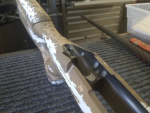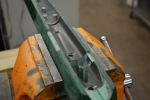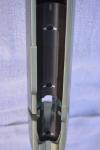If I may:
1. Bedding the lug serves a very different purpose from bedding the action. The lug has two functions. It distributes a force to the stock created by recoil and it serves to transmit the torsional force created by the bullet acclerating from zero to 200,000+rpm in a distance of almost nothing. The contact patch to the rear of the lug does the recoil work and the sides are for torsion.
Digging into this there's likely some "stiction" stuff going on where the back side plays into the torsion thing to some degree as well.
2. Bedding the action. All it is doing is providing a tension free register for the reciever. It's a casting, nothing more. Whether you have pillars or not means nothing for that purpose. The pillars are so that the stock does not compress when snugged up. In the old days where wood was the primary stock material, this became a bigger deal due to weather fluctuations and the natural tendency for the wood fibers to compress over time. With a composite that is by and large no longer the issue. We do it cause it's "monkey see..." and it hurts nothing. Protects the stock I guess from guard screws chewing on stuff, but that's about it.
As for the front/rear of the action debate:
There is no blanket answer. Repeaters are different from single shots. In a repeater you have a gaping hole down the center. This forces the recoil energy to be sent along the sides of the rifle stock. The stock is softer than the action. When the bang happens the reciever will do some wierd stuff, but the bulk of it happens in the rifle stock. The sides along the magazine box bulge slightly. This effectively makes the stock shorter for a split second, then they straighten back out again.
During this time, make no mistake, the rear of the receiver and the bedding are sliding against one another just like your car does on icy pavement. So, all the bedding in the world won't stop that.
Bedding the tang area serves a very different purpose. It's to ensure tangent contact over the broadest footprint possible so that the receiver does not distort when the screw is snugged up. Just like it wants to do on many chassis stocks using the conventional V setup. The tang narrows and it stops making contact before the screw centerline. In that condition you have a lever. The front of the action tries to levitate off the rifle stock.
Bedding along the sides along the magazine box really isn't doing a whole lot I'm afraid. This is proven where guns are inletted poorly. Guys do the front/rear and they shoot just fine. From a fit and finish perspective, it's not something I would ever want to see, but I'm not the sherrif so my opinion doesn't mean much.
If you have the tools to do so and the means, bed from one end to the other, it'll look a whole lot better.
3. Epoxy choice. All you want is a resin of low shrinkage and good tolerance to compression. It should have a high solids content and have a good tolerance to chemical exposure. Petroleum and ammonia being the two biggest concerns. I personally don't care for stuff that has a ferrous based filler material. I'm always worried about salts and humidity breaking it down and starting a cascading effect. Just my paranoia, I have no data to support that.
It should have at least a 45m open clamp time. That means you don't have to rush it. That is poison for a good bedding job.
Epoxy goofs, one is mixing. FEW people take the time to mix the resin and catalyst properly. I like a big flat plate of glass. I can see it as its spread thin and that also mitigates heat buildup. -Extending my work time. It also avoids the introduction of air bubbles.
4. Release Agents. I've used every type listed here. They all work. Crisco or a tube of Chapstick would work. The absolute best that I have found is a product I also sell on our site. McLube 1700L. It's aerosol and goes on whisper thin. It flashes dry slick. It does not contaminate the resin in any capacity. It does not require buffing. A can lasts us about 2 months. It doesn't take much. Not the cheapest stuff, but I can say with certainty that it is better than every other product listed in this page. If it wasn't, I'd still be doing it the "old way."
Hope this helps.
For those who've never seen LRI's bedding:



